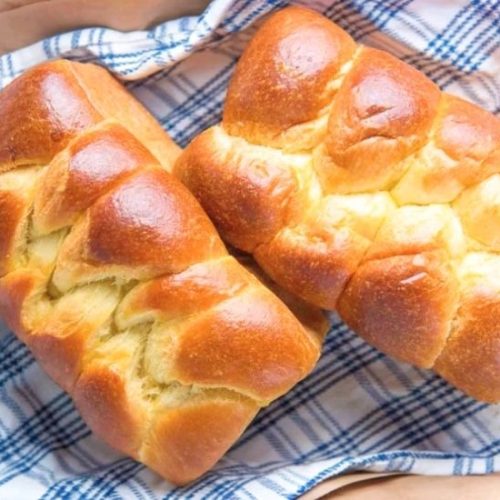
Mastering Brioche
This classic brioche bread recipe yields two loaves of soft, rich, and buttery bread that’s perfect for everything from breakfast to sandwiches. Combining eggs, butter, and a touch of honey, the dough develops a tender crumb with a delicate sweetness and golden crust. The process involves activating yeast, gradually incorporating softened butter, and an essential overnight chill that enhances flavor and makes shaping easier. Whether shaped into braided loaves or traditional forms, the brioche bakes to a beautiful golden brown with a light, airy texture. Ideal for intermediate bakers with a stand mixer, this recipe balances indulgence with straightforward technique, making it a wonderful choice for home baking projects or special occasions.
Equipment
- 1 Stand mixer with dough hook attachment
- 2 Loaf pans, 8.5 x 4 inches (or 9 x 5 inches)
- 1 Pastry Brush
- 1 Dough scraper/cutter
- (1) Cooling rack
Ingredients
- 120 mL warm milk
- 9 g active dry yeast
- 10 mL honey
- 5 large eggs
- 1 large egg yolk or 2 yolks if using 4 eggs total
- 10 mL vanilla extract
- 60 g granulated sugar about 5 tablespoons
- 500 g all-purpose flour approximately 4 cups plus 2 tablespoons, spooned and leveled
- 1 ½ teaspoons fine sea salt
- 250 g unsalted butter softened and divided into four portions (about 1 cup plus 2 tablespoons)
Instructions
- Activate the Yeast: In a large mixing bowl, combine the warm milk, active dry yeast, and honey. Stir gently and allow the mixture to rest for 10 minutes, letting the yeast bloom and become frothy.
- Combine Wet Ingredients: Add the eggs and the additional egg yolk to the yeast mixture. Lightly whisk everything together to blend the eggs evenly.
- Add Dry Ingredients and Initial Mixing: Stir in the vanilla extract, sugar, all-purpose flour, and sea salt. Mix until the ingredients come together into a rough, shaggy dough.
- Begin Kneading the Dough: Attach the dough hook to your stand mixer and knead the dough on a low to medium speed (2 or 3) for about 3 to 5 minutes until it starts to form a cohesive mass.
- Incorporate Butter Gradually: Add the softened butter in four separate portions. After each addition, knead the dough for 2 to 3 minutes to fully absorb the butter. Be sure to stop occasionally to scrape down the sides and bottom of the bowl to keep the dough well-mixed.
- Develop the Dough’s Texture: Once all butter is incorporated, increase the mixer speed to medium-high (5 or 6) and knead for an additional 5 to 15 minutes. The dough should become smooth, elastic, and slightly tacky but not sticky, easily lifting off the bowl.
- Shape and First Rise: Lightly flour your work surface and hands. Turn the dough out and fold the edges inward, pressing gently. Flip the dough over and shape it into a tight ball using the heels of your palms. Place it back into a clean bowl, cover, and let it rise in a warm spot (around 72°F) for approximately 1 hour, or until doubled in size.
- Deflate and Chill: Gently punch down the risen dough to release gas. Repeat the folding and ball-shaping steps, then cover the bowl and refrigerate the dough for at least 8 hours or up to 24 hours to develop flavor and improve handling.
- Prepare Pans and Divide Dough: Lightly butter and flour two standard loaf pans (about 8.5 x 4 inches or 9 x 5 inches). Remove the chilled dough from the fridge and gently flatten it on a floured surface. Weigh the dough and divide it into two equal portions using a dough cutter or sharp knife.
- Shape the Loaves: Option A: Nantaise Loaf — Divide one portion into eight equal pieces. Shape each into smooth balls by folding edges under and rolling with a cupped palm. Place the balls snugly in a loaf pan in a zig-zag pattern, flatten slightly.
- Option B: Braided Loaf — Divide a dough portion into three equal pieces. Roll each piece into 14-inch ropes, braid them tightly, pinch the ends, and place in the loaf pan.
- Option C: Traditional Loaf — Shape the dough into a classic loaf shape and place it into the prepared pan.
- Final Proof: Cover the pans with plastic wrap and let the dough rise at room temperature for about 2 hours or until nearly doubled and almost reaching the top of the pan.
- Bake to Perfection: Preheat the oven to 325°F (163°C). Brush the tops of the loaves with beaten egg wash. Optionally, sprinkle with pearl sugar for a sweet crunch. Bake for 35 to 45 minutes, or until golden brown and the internal temperature reaches 190°F (88°C).
- Cooling and Storage: Remove the loaves from the oven and cool for 5 minutes in the pans. Carefully turn out onto a wire rack to cool completely before slicing. Store in an airtight container to maintain freshness.
Notes
- Measuring Flour: For best results, weigh your flour rather than relying on volume measurements to ensure accuracy.
- Butter Temperature: Use unsalted butter that is very soft but not melted to incorporate smoothly into the dough.
- Overnight Chill: Refrigerating the dough overnight enhances flavor development and makes shaping easier.
- Proofing Environment: A warm, draft-free space around 72°F is ideal for rising; if your kitchen is cooler, allow extra time.
- Egg Wash Tip: For a deeper golden crust, apply a second egg wash halfway through baking.